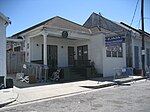St. Augustine Church (New Orleans)

St. Augustine Church is a Catholic parish in New Orleans. Established by free people of color, who also bought pews for slaves, it is said to be the oldest Black Catholic parish in the United States, established in 1841. It was one of the first 26 sites designated on the state's Louisiana African American Heritage Trail. The property on which St. Augustine stands was once part of the Claude Tremé plantation. It is now one of two Catholic parishes in the Faubourg Tremé. The church is located on Saint Claude Avenue at Governor Nicholls Street, a few blocks from North Rampart Street and the French Quarter. It was founded under Bishop Antoine Blanc, who later served as New Orleans' first Archbishop, and designed by the French architect J. N. B. de Pouilly, who worked on the expansion and renovation of the more famous St. Louis Cathedral on Jackson Square.
Excerpt from the Wikipedia article St. Augustine Church (New Orleans) (License: CC BY-SA 3.0, Authors, Images).St. Augustine Church (New Orleans)
Governor Nicholls Street, New Orleans French Quarter
Geographical coordinates (GPS) Address Phone number Website Nearby Places Show on map
Geographical coordinates (GPS)
| Latitude | Longitude |
|---|---|
| N 29.9652 ° | E -90.0662 ° |
Address
Saint Augustine Catholic Church
Governor Nicholls Street 1210
70116 New Orleans, French Quarter
Louisiana, United States
Open on Google Maps









